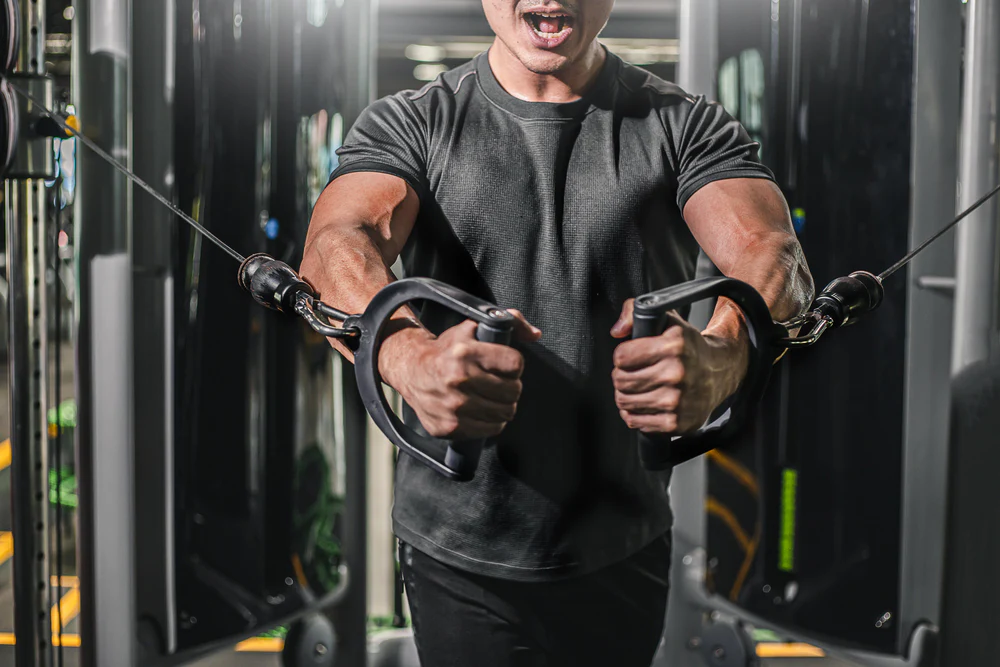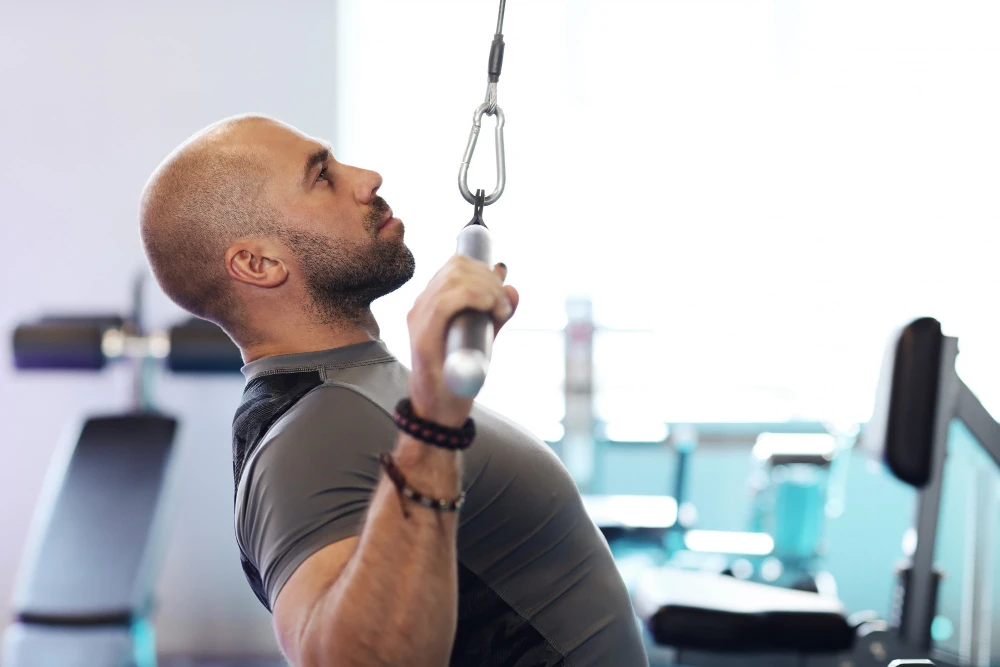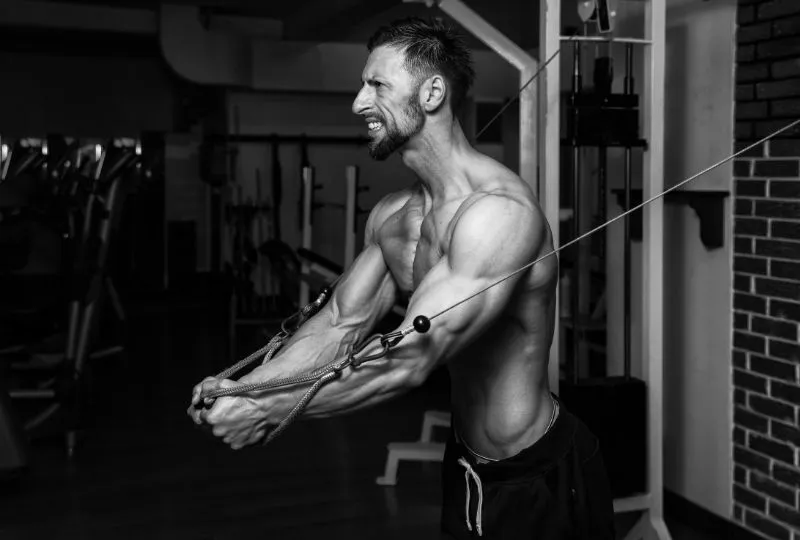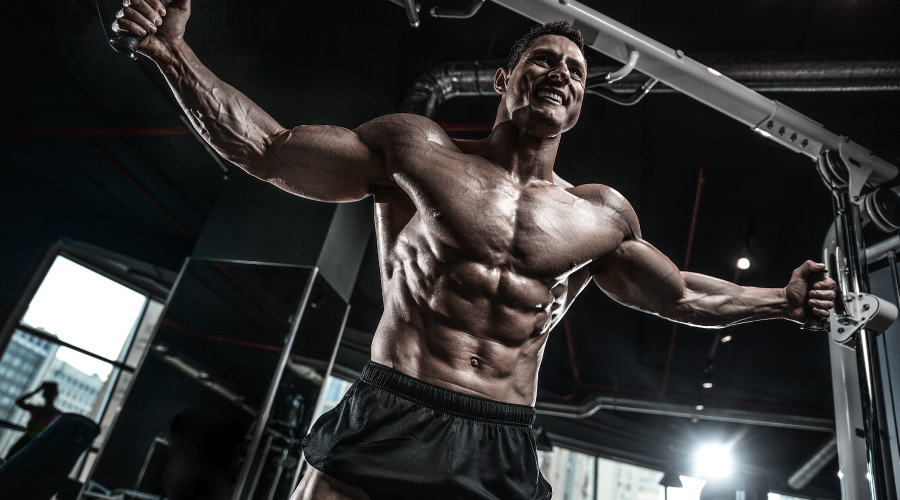Benefits of Cable Chest Exercises
Cable chest exercises offer a number of benefits, including:- Increased muscle activation. Cable machines allow for a greater range of motion and more targeted muscle activation than free weights. This is because the cables provide constant resistance throughout the entire range of motion, which helps to ensure that the chest muscles are working hard throughout the exercise.
- Improved posture. Cable chest exercises can help to improve posture by strengthening the muscles that support the spine and shoulder blades. This is because many cable chest exercises are performed in a standing position, which requires the core and back muscles to work together to maintain proper alignment.
- Reduced risk of injury. Cable chest exercises are generally considered to be safer than free weight exercises, as they allow for more control over the weight and the range of motion. This is because the cables provide a constant resistance, which helps to prevent the weight from being dropped or the range of motion from being exceeded.
- More variety of exercises. There are a variety of cable chest exercises that can be performed, which allows for more variety in your workouts. This can help to keep you motivated and prevent boredom.
- Increased functional strength. Cable chest exercises can help to increase functional strength, which is the ability to perform everyday tasks with ease. This is because cable exercises often require the use of multiple muscle groups, which helps to improve coordination and balance.

Cable Chest Exercises vs. Other Chest Exercises
While traditional chest exercises like dumbbell and barbell presses are effective for chest development, cable chest exercises offer unique advantages. One key difference is the constant tension provided by the cables. Unlike free weights, which rely on gravity and can provide less tension at certain points in the movement, cables maintain tension throughout the entire exercise, maximizing muscle activation.
Additionally, cable chest exercises allow for a greater range of motion compared to traditional exercises. With cables, you can perform exercises that target your chest muscles from various angles, providing a more comprehensive workout. This versatility helps you develop a well-rounded chest and prevent muscle imbalances.
Moreover, cable exercises allow for greater muscle isolation. By adjusting the cable attachments and positioning, you can specifically target your chest muscles without relying on other muscles to assist in the movement. This isolation helps you achieve better muscle definition and symmetry in your chest.
Proper Form and Technique for Cable Chest Exercises
To get the most out of your cable chest exercises, it’s crucial to maintain proper form and technique. Here are some guidelines to follow:
- Stance and Body Positioning: Stand with your feet shoulder-width apart and maintain a stable stance throughout the exercise. Keep your core engaged and your back straight to avoid unnecessary strain on your lower back.
- Grip and Hand Placement: Grab the handles or attachments firmly, ensuring a secure grip. For exercises targeting the upper chest, use a pronated (overhand) grip. For exercises targeting the middle and lower chest, use a supinated (underhand) grip.
- Range of Motion: Perform each exercise through a full range of motion to fully engage your chest muscles. Avoid using excessive momentum or swinging, as it reduces muscle activation and increases the risk of injury.
- Breathing: Breathe naturally throughout the exercise, inhaling during the eccentric (lowering) phase and exhaling during the concentric (lifting) phase. Avoid holding your breath, as it can increase intra-abdominal pressure and decrease stability.
- Controlled Movement: Focus on slow and controlled movements, emphasizing the contraction of your chest muscles. Avoid jerking or using momentum to move the weights, as it takes the tension off your chest muscles and reduces the effectiveness of the exercise.
By following these guidelines, you’ll ensure that you’re performing cable chest exercises with proper form and technique, maximizing muscle engagement and minimizing the risk of injury.

The Best Cable Chest Exercises for Upper Chest
- Cable Incline Bench Press: Attach a straight bar or D-handles to the high pulleys and set the bench at a 30-45 degree incline. Sit on the bench and grasp the handles with a pronated grip. Press the handles forward while maintaining control and a slow tempo. Squeeze your chest at the top of the movement and slowly return to the starting position.
- Single-Arm Cable Crossover: Set the pulleys to the highest position and stand in the center of the cable machine. Grab one handle with an underhand grip and step forward, creating tension in the cable. Keeping your arm slightly bent, bring it across your body in a sweeping motion, focusing on squeezing your chest. Return to the starting position and repeat on the other side.
- High-to-Low Cable Flyes: Set the pulleys to the highest position and stand facing away from the machine. Grab the handles with a pronated grip and step forward, creating tension in the cables. With a slight bend in your elbows, bring your hands down and together in a sweeping motion, emphasizing the contraction in your upper chest. Return to the starting position in a controlled manner.
These exercises specifically target the upper chest muscles, helping you develop a well-defined and sculpted upper chest.
The Best Cable Chest Exercises for Middle Chest
- Cable Decline Bench Press: Attach a straight bar or D-handles to the low pulleys and set the bench at a decline angle. Lie on the bench and grasp the handles with a supinated grip. Press the handles forward while maintaining control and a slow tempo. Squeeze your chest at the top of the movement and slowly return to the starting position.
- Single-Arm Cable Press: Set the pulleys to the lowest position and stand facing away from the machine. Grab one handle with an overhand grip and step forward, creating tension in the cable. With a slight bend in your elbow, press the handle forward and across your body, focusing on squeezing your middle chest. Return to the starting position and repeat on the other side.
- Mid-to-Low Cable Flyes: Set the pulleys to the middle position and stand facing away from the machine. Grab the handles with a supinated grip and step forward, creating tension in the cables. With a slight bend in your elbows, bring your hands up and together in a sweeping motion, emphasizing the contraction in your middle chest. Return to the starting position in a controlled manner.
These exercises target the middle chest muscles, helping you achieve a well-developed and balanced chest.
The Best Cable Chest Exercises for Lower Chest
- Cable Dips: Attach two handles to the high pulleys and set them slightly wider than shoulder-width apart. Position yourself between the handles and hold onto them with a pronated grip. Lower your body by bending your elbows and leaning forward, feeling the stretch in your chest. Push your body back up to the starting position, focusing on squeezing your lower chest.
- Low Cable Crossover: Set the pulleys to the lowest position and stand in the center of the cable machine. Grab one handle in each hand with an overhand grip. Step forward, creating tension in the cables. With a slight bend in your elbows, bring your hands up and together in a sweeping motion, emphasizing the contraction in your lower chest. Return to the starting position in a controlled manner.
- Decline Cable Flyes: Attach D-handles to the low pulleys and set the bench at a decline angle. Lie on the bench and grasp the handles with a pronated grip. With a slight bend in your elbows, bring your hands up and together in a sweeping motion, emphasizing the contraction in your lower chest. Return to the starting position in a controlled manner.
These exercises target the lower chest muscles, helping you develop a strong and well-defined lower chest.
Advanced Variations of Cable Chest Exercises
Once you’ve mastered the basic cable chest exercises, you can incorporate advanced variations to further challenge your chest muscles and stimulate growth. Here are a few advanced variations to try:
- Cable Chest Press with Bands: Attach resistance bands to the handles of the cable machine and perform the cable chest press. The added resistance from the bands increases the difficulty of the exercise, providing a greater stimulus for muscle growth.
- Single-Arm Cable Flyes: Perform cable flyes using one arm at a time instead of both arms simultaneously. This variation requires greater stability and control, engaging your core muscles in addition to your chest muscles.
- Cable Push-Ups: Attach the handles to the low pulleys and set the bench parallel to the cable machine. Place your hands on the handles and assume a push-up position. Lower your body by bending your elbows and keeping your elbows close to your sides. Push your body back up to the starting position, focusing on squeezing your chest.
Incorporating these advanced variations into your workout routine will challenge your chest muscles in new ways and help you overcome plateaus in your chest development.
Incorporating Cable Chest Exercises into Your Workout Routine
To effectively incorporate cable chest exercises into your workout routine, consider the following tips:
- Exercise Selection: Choose a variety of cable chest exercises that target different areas of your chest. Include exercises for the upper, middle, and lower chest to ensure well-rounded development.
- Order of Exercises: Start your chest workout with compound exercises like the cable bench press or cable dips to target multiple chest muscles simultaneously. Follow up with isolation exercises like cable flyes to focus on specific areas of your chest.
- Sets and Reps: Aim for 3-4 sets of each exercise, performing 8-12 reps per set. Adjust the weight to challenge yourself while maintaining proper form.
- Rest Periods: Allow for adequate rest between sets, typically 1-2 minutes. This will ensure that your muscles recover sufficiently before the next set.
- Progressive Overload: Increase the weight or resistance gradually over time to continue challenging your chest muscles and promoting growth.
By following these tips, you can effectively incorporate cable chest exercises into your workout routine and maximize your chest development.

Common Mistakes to Avoid When Performing Cable Chest Exercises
To get the most out of your cable chest exercises and prevent injuries, avoid these common mistakes:
- Using Excessive Weight: Using too much weight can compromise your form and increase the risk of injury. Start with lighter weights and focus on proper technique before gradually increasing the resistance.
- Poor Posture: Maintain proper posture throughout the exercises. Avoid rounding your shoulders or arching your back excessively, as it can put unnecessary strain on your joints and muscles.
- Lack of Range of Motion: Perform each exercise through a full range of motion to engage your chest muscles fully. Avoid cutting the range of motion short or using momentum to complete the movement.
- Neglecting Stability Muscles: Cable chest exercises require stability and control. Neglecting to engage your core and other stabilizing muscles can limit your progress and increase the risk of injury.
- Not Adjusting Cable Attachments: Adjust the cable attachments and positioning to suit your body mechanics and target the desired chest muscles effectively. Failing to adjust the cables can result in ineffective targeting of the chest muscles.
By avoiding these common mistakes, you’ll ensure that you’re performing cable chest exercises correctly and maximizing your chest development.
Let’s Sum Up
Cable chest exercises are a powerful tool in your chest workout arsenal. They provide constant tension, target your chest muscles from different angles, and allow for a greater range of motion compared to traditional exercises. By incorporating the best cable chest exercises into your workout routine, you can sculpt a massive chest and strengthen your upper body.
Remember to maintain proper form and technique, choose exercises that target different areas of your chest, and gradually increase the weight or resistance to continue challenging your muscles. With consistency and dedication, you’ll be well on your way to achieving the chest of your dreams. So, grab those cables, put in the work, and watch your chest transform into a powerful symbol of strength and masculinity.
You May Also Like



